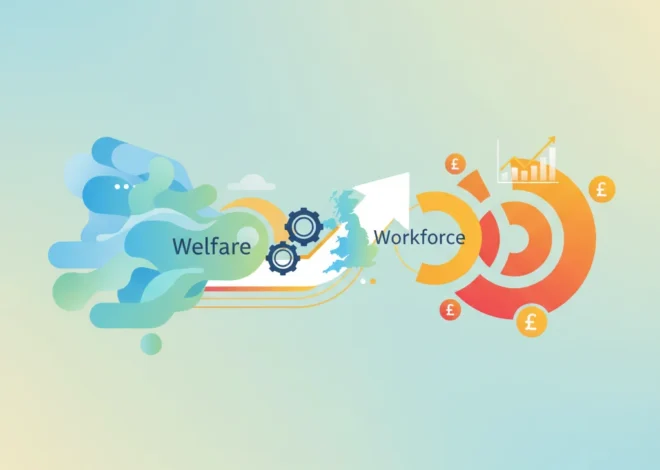
The Unlikely Canary: What a 33% Plunge in UK Porn Traffic Reveals About the Future of Fintech and Investing
A Digital Drawbridge is Raised: The Surprising Economic Experiment Unfolding in the UK
In the world of finance and investing, market signals often come from expected places: inflation reports, central bank announcements, or corporate earnings calls. But sometimes, the most profound insights emerge from the unlikeliest of corners. In July, the British government enacted new, stricter age verification rules for adult websites, a key provision of its wide-ranging Online Safety Act. The immediate result? A staggering one-third drop in traffic to these sites, according to data reported by the Financial Times. While the headline might elicit a smirk, for savvy investors, business leaders, and financial professionals, this development is far from trivial. It’s a live, large-scale stress test of one of the most critical—and lucrative—arenas in modern technology: digital identity verification.
This isn’t just a story about regulating the internet’s murkier corners. It’s a crucial case study in user friction, regulatory impact, and the burgeoning multi-billion dollar financial technology (fintech) sector dedicated to proving we are who we say we are online. The lessons being learned from this digital exodus have direct implications for everything from mobile banking and online trading platforms to the very architecture of our future economy. What happens when you introduce a mandatory identity checkpoint in a high-volume digital environment? The UK just gave us a multi-million user answer, and the world of finance should be paying close attention.
Quantifying Compliance: The Economics of a One-Third Decline
The 33% traffic decline is more than a statistic; it’s a hard-dollar figure representing the cost of friction. In economics, “friction” refers to any force that prevents a market from operating with perfect efficiency. In this case, the friction is the new requirement for users to prove their age, a process that can involve uploading an ID, using a third-party verification app, or other methods that add steps, time, and privacy concerns to what was previously a seamless (if unregulated) process.
This scenario provides a rare, quantifiable look at the trade-off between security and user experience. For any digital business, from a neobank to an e-commerce giant, reducing customer drop-off during onboarding is paramount. This UK experiment demonstrates that a significant portion of a potential user base will abandon a process if it becomes even moderately inconvenient. This has profound implications for the financial services industry, which is legally mandated to perform far more intensive identity checks—known as Know Your Customer (KYC) and Anti-Money Laundering (AML) procedures.
A 2022 report highlighted that financial institutions can lose up to 40% of new customers during the onboarding process due to friction and complexity (source). The UK’s experience with adult sites validates this concern in a different sector, suggesting that user impatience is a universal constant. The key takeaway for the banking and trading sectors is clear: the efficiency, speed, and perceived privacy of your identity verification process is not a back-office compliance issue—it’s a front-line competitive advantage that directly impacts your bottom line and stock market valuation.
The Green Paradox: Why the Netherlands' Renewable Success Is a Critical Warning for Global Investors
The Multi-Billion Dollar Answer: The Rise of the Digital Identity Fintech Sector
This regulatory push creates an enormous business opportunity. The global digital identity market is projected to grow from around $34.5 billion in 2023 to over $116 billion by 2030, according to Fortune Business Insights. This explosive growth is fueled by the exact challenge the UK is now facing: the need for reliable, scalable, and user-friendly ways to verify identity online. This is the new frontier of fintech, and it’s attracting massive amounts of venture capital and public market investing interest.
Companies in this space offer a variety of solutions, each with its own balance of security, cost, and user friction. Understanding these methods is key to grasping the investment landscape.
Below is a simplified comparison of common digital verification technologies that power this burgeoning sector of financial technology.
| Verification Method | How It Works | Pros | Cons |
|---|---|---|---|
| Document Scanning (IDV) | User uploads a photo of a government-issued ID (e.g., driver’s license, passport). AI verifies its authenticity. | High security, widely accepted for KYC. | High friction, privacy concerns, potential for data breaches. |
| Biometric Verification | Uses facial recognition or fingerprint scanning to match a user to their ID photo or a stored profile. | Very high security, difficult to spoof. | Significant privacy implications, requires specific hardware (camera/scanner). |
| Digital Identity Wallets | A third-party app (e.g., from a bank or a dedicated provider) holds pre-verified credentials that can be shared with sites. | Low friction for repeat use, user controls data. | Requires initial setup, dependent on the adoption of the wallet provider. |
| Database/Credit Bureau Check | Cross-references user-provided information (name, address) against existing financial or public databases. | Low user friction, leverages existing data. | Less secure, can be defeated by stolen information, may not work for “thin-file” individuals. |
Each of these technologies represents a different investment thesis. An investor might bet on the high-security, high-friction document scanning companies as the go-to for banking compliance, or they might see digital wallets as the future of consumer-facing verification, a classic growth play in the fintech space.
From Adult Sites to Trading Accounts: Universal Lessons for Finance
The parallels between verifying age for an adult website and opening a new account on a stock trading platform are stronger than they first appear. Both processes act as a gateway to a desired service, and both are now subject to increasing regulatory scrutiny. The core challenge is identical: how to comply with regulations without alienating the customer.
For decades, the banking industry has treated KYC as a necessary evil—a costly, cumbersome process that slows down growth. The fintech revolution was partly built on challenging this notion, using superior technology to make onboarding faster and smoother. The UK’s age verification experiment serves as a stark reminder that this battle is far from over. Any financial institution that fails to invest in seamless, secure, and respectful identity verification technology risks being outmaneuvered by more agile competitors.
The key lessons for the financial sector are:
- Friction is a Conversion Killer: The 33% drop is a universal benchmark. Every extra click, every confusing instruction, and every minute of waiting pushes potential customers away.
- Choice Matters: Offering multiple verification methods (e.g., letting a user choose between scanning an ID or connecting a trusted bank account) can significantly improve completion rates.
- Privacy is Not an Afterthought: Users are increasingly wary of how their data is used. The most successful solutions will be those that build trust and give users a sense of control over their personal information.
The Investor’s Lens: Where is the Smart Money Going?
For investors, this regulatory shift acts as a powerful market catalyst. It separates the technologically advanced fintech companies from the laggards. When evaluating the investment potential of companies in the digital identity and compliance tech space, the focus should be on a few key performance indicators that go beyond standard financial metrics.
Here are some potential investment theses for navigating this evolving corner of the stock market and private equity.
| Investment Thesis | Description | Example Focus | Risk Profile |
|---|---|---|---|
| The “Picks and Shovels” Play | Investing in the pure-play technology providers that power verification for other businesses across multiple industries. | Publicly traded identity verification specialists, AI document analysis firms. | Medium. Tied to the overall growth of the digital economy and regulation. |
| The Incumbent Innovator | Betting on large, established financial institutions or credit bureaus that are successfully integrating modern fintech identity solutions. | Major banks with high app store ratings for onboarding, credit rating agencies acquiring identity startups. | Low to Medium. Slower growth but potentially more stable. |
| The Decentralized Disruptor | Venture-style investing in startups using blockchain or other decentralized tech to build next-generation identity protocols. | Early-stage companies focused on Self-Sovereign Identity (SSI) and Web3 applications. | High. Potential for massive returns but also complete failure. |
| The Regional Champion | Focusing on companies poised to win in specific, large-scale regulatory environments (e.g., experts in EU’s eIDAS or India’s Aadhaar). | Fintech firms with deep government contracts and localized expertise. | Medium. Concentrated regulatory risk. |
The UK’s policy, and others like it that will inevitably follow globally, will create clear winners and losers. Companies that can solve the puzzle of high-security, low-friction verification will command premium valuations and become essential infrastructure for the entire digital economy.
Grounded: How Government Shutdowns Create Turbulence for the Economy and Your Investments
Conclusion: The Macro View from a Micro-Event
The sudden drop in UK traffic to adult websites is more than a sociological curiosity; it’s a vital economic signal. It provides a real-world, at-scale demonstration of the financial cost of digital friction and the immense opportunity awaiting the financial technology companies that can solve it. This single regulatory change has illuminated the challenges and opportunities at the intersection of technology, privacy, and commerce.
For investors, entrepreneurs, and leaders in banking and finance, the message is clear. The business of identity is becoming a cornerstone of the digital economy. The platforms and protocols that win this race will not only unlock tremendous value but will also write the rules for how we interact, transact, and trust each other online for decades to come. It’s a fundamental shift, and as is so often the case, the first tremors were felt in a place no one was looking.


